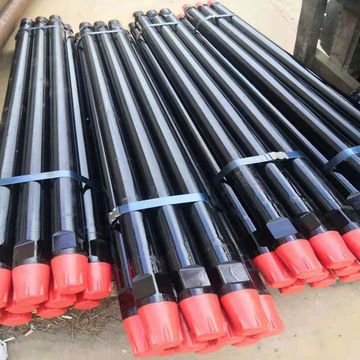Share some tips for daily use of mining drill pipe
Related products Link:
Mining drill pipe is a steel pipe with threads at the end, which is used to connect the surface equipment of the drilling rig and the drilling and grinding equipment or the bottom hole device at the bottom of the drilling well. The purpose of the drill pipe is to transport the drilling mud to the drill bit and together with the drill bit to raise, lower or rotate the bottom hole device.
Mining drill pipe must be able to withstand enormous internal and external pressure, twisting, bending and vibration. In the process of oil and gas extraction and refining, the drill pipe can be used many times.
So what skills do we have when applying mining drill pipes? Let's find out together.
1. The drill pipe needs to be maintained regularly to determine the maintenance cycle, and to carry out anti-rust and dust-proof treatment on a regular basis.
2. The use of the drill pipe must be within the rated drilling distance of the drilling rig, and the matching drill pipe should be used according to the technical parameter model of the drilling distance.
3. The geological drill pipe is friction-welded with the special geological drilling pipe for mining and its matching joints, so it has good follow-up and high tensile strength, and can be used in conventional drilling and gas discharge. When operating in hard rock formations, coal seams or other special environments, it is necessary to determine the drilling depth based on the actual physical properties and parameters of the drill pipe material.
4. When the drill pipe and the drill bit are used together, the drill bit should be larger than the diameter of the drill pipe under normal circumstances, and the condition of the drill rig and the drill pipe should always be paid attention to during the drilling process. In case of drill sticking, sudden death, etc., the drill should be stopped immediately or drilled slowly after returning to ensure that the drill pipe is not bent and flat.
5. When the drill pipe is ventilated or passed through water, it should be confirmed that the drill pipe is tightly connected when drilling. When the drill pipe has seals, such as O-rings, etc., pay attention to the use of the seals, and replace the seals in time when damage or corrosion occurs. After the drilling is completed, do maintenance and cleaning work on the seals.
6. When the drill pipe is drilled, it should be manually tightened gently to ensure a tight fit (thread type). Do not use the drilling rig to drill directly to prevent damage to the drill pipe.
7. If the bending degree of the drill pipe exceeds the standard requirement after use or the screw thread is damaged and cannot work normally, it should be scrapped in time or returned to the factory for repair.
8. According to the requirements of the standard, the drilling depth of the drill pipe should be combined with the relevant geological drilling requirements to prevent the drill pipe from falling off due to the drilling depth reaching the limit of the drill pipe.
9. When working in acid and alkali areas, attention should be paid to the corrosion of drill pipes. When the drilling is completed, the surface of the rod body should be cleaned with clean water in time to remove the corrosion layer.
10. Drill pipes need to be stored in a dry place, and the bottom should be supported at multiple points. During long-term storage, drill pipes should be regularly maintained.
11. Drill pipes must not be used as a support platform for stacking heavy tails, and drill pipes must not be randomly placed under gravel and coal piles or piled up randomly.
12. After the drill pipe is maintained and derusted/dust cleaned, the protective cap should be buckled or sealed in a box to ensure that the drill pipe is always new.





